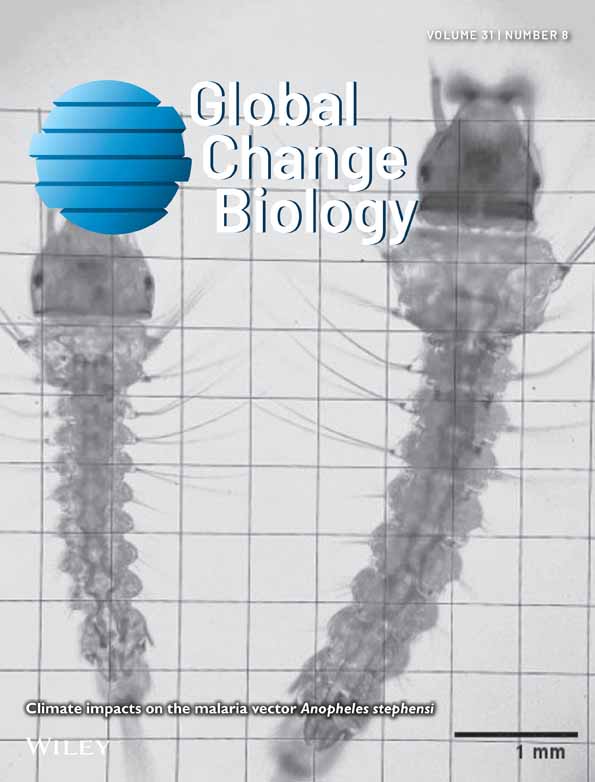Increased heat requirement for leaf flushing in temperate woody species over 1980–2012: effects of chilling, precipitation and insolation
Abstract
Recent studies have revealed large unexplained variation in heat requirement-based phenology models, resulting in large uncertainty when predicting ecosystem carbon and water balance responses to climate variability. Improving our understanding of the heat requirement for spring phenology is thus urgently needed. In this study, we estimated the species-specific heat requirement for leaf flushing of 13 temperate woody species using long-term phenological observations from Europe and North America. The species were defined as early and late flushing species according to the mean date of leaf flushing across all sites. Partial correlation analyses were applied to determine the temporal correlations between heat requirement and chilling accumulation, precipitation and insolation sum during dormancy. We found that the heat requirement for leaf flushing increased by almost 50% over the study period 1980–2012, with an average of 30 heat units per decade. This temporal increase in heat requirement was observed in all species, but was much larger for late than for early flushing species. Consistent with previous studies, we found that the heat requirement negatively correlates with chilling accumulation. Interestingly, after removing the variation induced by chilling accumulation, a predominantly positive partial correlation exists between heat requirement and precipitation sum, and a predominantly negative correlation between heat requirement and insolation sum. This suggests that besides the well-known effect of chilling, the heat requirement for leaf flushing is also influenced by precipitation and insolation sum during dormancy. However, we hypothesize that the observed precipitation and insolation effects might be artefacts attributable to the inappropriate use of air temperature in the heat requirement quantification. Rather than air temperature, meristem temperature is probably the prominent driver of the leaf flushing process, but these data are not available. Further experimental research is thus needed to verify whether insolation and precipitation sums directly affect the heat requirement for leaf flushing.
Introduction
In plants, the timing of spring phenological events, such as leaf flushing or fruit ripening, is related to the temperature sum of the preceding period (Réaumur, 1735). This temperature sum, also called the heat requirement, is often calculated using the classical growing degree day concept (Wang, 1960; Baskerville & Emin, 1969; Sarvas, 1972; Chuine et al., 1998). Growing degree day-base dphenology models are widely used to simulate plant phenology and their response to climate change (Chuine, 2000; Schwartz, 2003; Hänninen & Kramer, 2007; Richardson et al., 2013). However, recent studies have revealed that this approach can lead to large unexplained variation, resulting in considerable uncertainty when predicting ecosystem carbon and water balance responses to climate variability (Levis & Bonan, 2004; Kucharik et al., 2006; Piao et al., 2007; Randerson et al., 2009; Jeong et al., 2012; Keenan et al., 2012; Migliavacca et al., 2012; Richardson et al., 2012). To decrease such uncertainties, we need to improve our understanding of how heat requirements may interact with other environmental cues to affect spring phenology. By exploring these potential correlations, predictions of spring phenology could be improved and hence increase our understanding of the global carbon balance in the context of climate warming (Richardson et al., 2012).
The concept of heat requirement for spring leaf flushing implies that temperate woody species require a certain amount of heat to initiate leaf flushing after winter dormancy. The concept of accumulated heat is most often used as a measure for the physiological time or heat requirement (Baskerville & Emin, 1969; Wilson & Barnett, 1983). Theoretically, the heat requirement for leaf flushing remains (relatively) constant, even if temperatures during dormancy vary from year to year (Baskerville & Emin, 1969; Wilson & Barnett, 1983). As such, several studies that compare phenology models have reported that models with constant heat requirement performed similarly or even better than more sophisticated models that account for other environmental drivers (Linkosalo et al., 2008; Vitasse et al., 2011). However, there are also numerous studies suggesting that the amount of heat required to initiate leaf flushing after winter is inversely correlated with the duration of cold temperatures during dormancy (hereafter called chilling requirement) (Murray et al., 1989; Botta et al., 2000; Zhang et al., 2004; Harrington et al., 2010; Jeong et al., 2012; Fu et al., 2013). Considering the rapid rise of winter temperatures in the Northern Hemisphere (IPCC, 2014; Fu et al., 2014b), chilling accumulation may have decreased below the required chilling threshold in many regions during the past decades, which subsequently may have resulted in increased heat requirement for spring leaf flushing. In this study, we therefore test the hypothesis that heat requirement for leaf flushing has increased in recent decades in the Northern Hemisphere due to warming winters that have provided lower duration/amount of chilling accumulations (Fu et al., 2014b).
Among temperate woody species, different chilling and heat requirements for leaf flushing have been documented. For example, Murray et al. (1989) reported larger chilling requirement for late flushing species (such as Fagus sylvatica L.) than for early flushing species. Analysis of the Belgian phenology network dataset indicated larger chilling requirement for Fagus sylvatica L. than for Quercus robur L. and Betula pendula L. (Fu et al., 2012a). This species-specific chilling requirement suggests differentiated heat requirement responses to climate warming. Unlike late flushing species, changes in the heat requirement of some early flushing species are more likely to be subtle or even absent, because their low chilling requirement may be still fulfilled in warmer winters. Therefore, we expect a more pronounced increase in heat requirement over the last decades in late than in early flushing species. How the temporal changes of chilling accumulation are affecting the heat requirement for spring leaf flushing among different woody species has not yet been thoroughly investigated at large scales and over large areas.
Besides winter chilling, the heat requirement for initiating leaf flushing may also be influenced by other environmental factors, such as day length (Wareing, 1953; Heide, 1993; Basler & Körner, 2012, 2014), light intensity (Partanen et al., 1998, 2001; Fitter & Fitter, 2002; Caffarra & Donnelly, 2011) and precipitation (Yuan et al., 2007; Piao et al., 2011; Shen, 2011; Fu et al., 2014c). The mechanism of light control on plant phenology is still unclear because of the difficulty to disentangle the effects of day length and light intensity (Calle et al., 2010), especially given their correlation with temperature. Total daily insolation could be used as an integrated measure of solar intensity at a particular site and day of the year (Calle et al., 2010). In this study, we therefore investigate the correlation between heat requirement and light using the sum of daily absorbed downward short wave radiation over the time period preceding leaf flushing (hereafter referred to as insolation sum). Other studies have suggested an important role for precipitation (Yuan et al., 2007; Piao et al., 2011; Shen, 2011). A positive spatial correlation between heat requirement and precipitation sum was found over the northern middle and high latitudes using remote sensing-based NDVI data (Fu et al., 2014c). In contrast, in areas with dry winters (e.g. Central Asia), negative spatial correlations were found between precipitation and heat requirement (Yu et al., 2003). Moreover, the above-mentioned spatial correlations do not necessarily hold interannually (Dunne et al., 2004; Jochner et al., 2013). Therefore, a temporal analysis of the correlations between heat requirement, chilling, precipitation and insolation sum, using long term in situ data, may provide insights into the relative importance of these three environmental factors in determining spring leaf flushing dates and how these are affected by global warming.
In this study, we estimated the species-specific heat requirement for leaf flushing of 13 temperate woody species by combining long term, in situ series of phenological observations from Europe and North America and gridded climate data. The species were defined as early and late flushing species according to the mean date of leaf flushing across all observation sites. We applied a partial correlation analysis to determine the temporal correlations between heat requirement and chilling accumulation, sum of precipitation and insolation during the dormancy period. The objectives of our analysis were (1) to determine the temporal changes of heat requirement for spring leaf flushing over the period 1980–2012, specifically we test the hypothesis that a more pronounced increase in heat requirement in late than in early flushing species; and (2) to relate changes in the heat requirement for leaf flushing to differences in chilling, precipitation and insolation.
Materials and methods
In situ phenology dataset and climate data
An extensive dataset of in situ phenology observations across northern temperate regions was obtained from the Pan European Phenology network (http://www.pep725.eu/), which provides an open European phenological database comprising multiple plant phenological records. Additionally, a phenology dataset for Syringa chinensis (lilac) was obtained from a network of sites distributed across the US (USA National Phenology Network, USA-NPN, https://www.usanpn.org/results/data). For this study, we selected the records of leaf flushing date of 13 woody species for the period 1980–2012. Data were excluded from the analysis when the study species were reported to flush later than the end of June. The details of the selected species are shown in Table 1. The leaf flushing dates extracted from the PEP dataset were defined according to the BBCH code (Biologische Bundesanstalt, Bundessortenamt und Chemische Industrie) (Meier et al., 2007), whereas leaf flushing dates from USA-NPN lilac dataset were defined as the first observation when leaf flushing occurs. For each species, leaf flushing dates were recorded at least in 10 phenological sites reporting minimum 15 year data records over the period 1980–2012. In total, 2594 phenological sites and 315 142 phenological records were used. The location of the selected phenological sites is shown in Fig. 1.
| Species | N | LU (DOY) | LU changes (days) | Heat requirement (HU) | Heat requirement changes (HU) | Ratio (%) | |||
|---|---|---|---|---|---|---|---|---|---|
| Scientific name | Common name | Mean | SD | Mean | SD | ||||
| Syringa chinensis | Lilac | 29 | 105 | −3.2 | 98.3 | 70.6 | 25.7 | 30.2 | 26 |
| Alnus glutinosa | European alder | 1529 | 107 | −13.7 | 166.4 | 44.8 | 70.7 | 46.9 | 42 |
| Pyrus communis | European Pear | 18 | 107 | −13.1 | 191.9 | 59 | 88.1 | 49 | 46 |
| Sorbus aucuparia | Rowan | 1115 | 107 | −5.5 | 169.9 | 44.9 | 59.3 | 42.5 | 35 |
| Aesculus hippocastanum | Chestnut | 2348 | 109 | −12 | 166.3 | 45.9 | 77.2 | 45.3 | 46 |
| Betula pendula | Silver birch | 2355 | 109 | −10.6 | 165.4 | 48.2 | 71.7 | 45.5 | 43 |
| Corylus avellana | European filbert | 128 | 112 | −7.8 | 115.8 | 91.9 | 33.8 | 30.9 | 29 |
| Fagus sylvatica | European beech | 1965 | 117 | −13.5 | 203.4 | 56.3 | 102.3 | 48.7 | 50 |
| Tilia cordata | Littleleaf linden | 115 | 118 | −10.9 | 177.7 | 90.5 | 70.3 | 37.2 | 40 |
| Acer platanoides | Norway maple | 69 | 119 | −8.6 | 146.7 | 111.9 | 55.9 | 42.6 | 38 |
| Quercus robur | European oak | 2045 | 123 | −16.3 | 246.4 | 48.8 | 127.3 | 56.6 | 52 |
| Robinia pseudoacacia | Black locust | 21 | 124 | −17.1 | 248.3 | 131.3 | 80.9 | 40.1 | 33 |
| Fraxinus excelsior | Ash | 1569 | 127 | −16.6 | 271.6 | 53.2 | 131 | 57.2 | 48 |
| All species | 2596 | 115 | −12.7 | 196.8 | 66.0 | 91.0 | 55.5 | 46 | |
- N indicates the number of observation sites, LU is the mean date of leaf flushing across all sites for each species; DOY is day of the year; HU is the heat unit, Ratio is the relative changes in heat requirement (%).
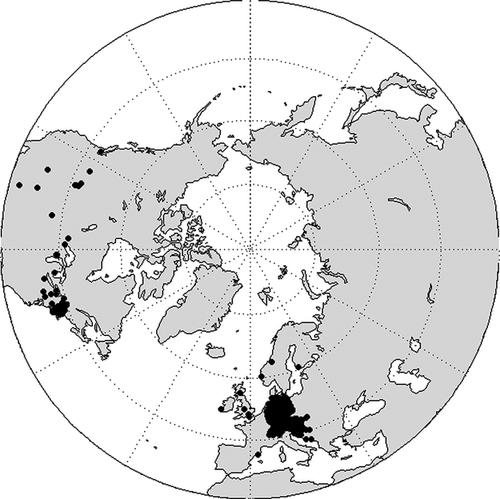
We used a gridded climate dataset, including daily mean air temperature, precipitation and insolation (absorbed downward short wave radiation), with a spatial resolution of 0.5°. The climate data were obtained from a bias-corrected reanalysis climate dataset covering the study period, that is 1980–2012 (Beer et al., 2014). To investigate the correlation between heat requirement and precipitation and insolation sum, we calculated the cumulative precipitation and insolation as the sum of the precipitation and insolation during the dormancy period that was defined as the time period from the day when the land surface first froze in the previous autumn to the day of leaf flushing. The soil freeze status was derived from the land surface dielectric status, obtained by passive microwave remote sensing. Specifically, we used combined datasets obtained by SMMR and SSM/I, providing daily land surface freeze status from 1979 to 2011 with a spatial resolution of 25 km (Kim et al., 2012). In the year 2012 and for the years when the land surface did not freeze, the onset date of the dormancy period was fixed on the mean date of land freeze over the study period 1980–2012. At those sites where the soil never froze during the study period, the starting date of heat accumulation was fixed on 1st January.
Heat requirement for spring leaf flushing
 (1)
(1) (2)
(2)where HUreq is the heat unit (HU) requirement for leaf flushing, DHU is the daily heat unit, tLFis the day of leaf flushing, t0 is the starting date for heat accumulation, Tth is the threshold temperature for heat accumulation, and Tt is the mean daily air temperature. The parameter values of the function (2) were fitted by Hänninen (Hänninen, 1990) based on Sarvas' experimental results on Betula pendula Betula pubescens and Populus tremula in Finland (Sarvas, 1972). Temperatures above 5 °C normally contribute to heat accumulation in temperate regions (Smith & Kefford, 1964; Perry, 1971; Hänninen, 1990; Kramer, 1994a) (but 0 °C in Sarvas' study) and is therefore used as a threshold for Tth. Physiologically, t0 is the date when endodormancy is released (Lang et al., 1987; Hänninen, 1990), here assumed to be the day when the land surface freezes or otherwise January 1st (see earlier). The heat requirement for leaf flushing was calculated using both equations (1) and (2), but the results were very similar (1), as shown in Figs S1 and S2. Hereafter, we therefore only report results obtained with the sigmoid function.
 (3)
(3)where CDreq is chilling requirement, tLF is the day of leaf flushing and t0 is the starting date for chilling accumulation. As for heat accumulation, t0 was fixed on the onset date of the dormancy period, approximated as the date when the land surface froze or as January 1st. We also used 1st September in the previous year as the start day of chilling accumulation (following Chuine, 2000), and similar results were found. We therefore only report the results obtained with the onset date of the dormancy period as the starting date for chilling accumulation.
Data analysis
For each phenological site, linear regression analyses of the dates of leaf flushing and heat requirement for leaf flushing, as well as chilling accumulation, precipitation sum and insolation sum during dormancy, against year, were performed for each species during the study period 1980–2012. Histograms were made to show the frequency distribution of the regression coefficients for each of these variables, that is leaf flushing dates, heat requirement, chilling accumulation, and precipitation and insolation sum, across all species. The mean values of the regression coefficients were defined as the temporal trends of leaf flushing and heat requirement for each species as well as across all species. The difference in heat requirement and temporal trends of heat requirement among species were tested using independent t-test and were quantified using linear regression.
We applied a partial correlation analysis between heat requirements and chilling accumulation, precipitation and insolation sum. The heat requirement and the other climate variables were detrended before the partial correlation analysis was conducted. This method has been successfully applied to remove covariate effects between multiple influential factors (Beer et al., 2010; Peng et al., 2013; Fu et al., 2014a), that is chilling, precipitation and insolation in this study.
Results
Temporal changes of heat requirement for leaf flushing
During the study period 1980–2012, the date of leaf flushing advanced at almost 90% of the study sites (significantly at almost 50%). On average, the date of leaf flushing advanced by 13 days across all observation sites (Fig. 2, grey histogram). An advancing trend was observed in all species, but this phenological shift was more pronounced in late than in early flushing species (Table 1).
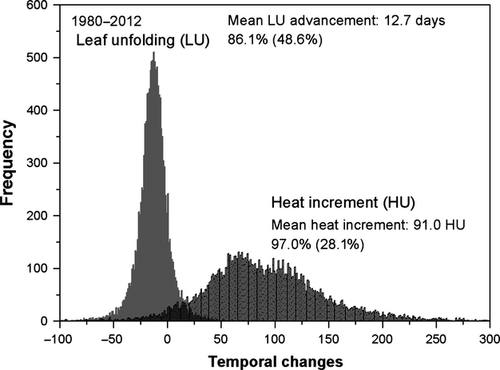
The heat requirement for leaf flushing was significantly different among the study species (df = 1, 12, F = 740.0 P < 0.001), with late flushing species exhibiting as expected the highest heat requirement. Assuming a linear relationship, the heat requirement for leaf flushing increased significantly (P = 0.002), at a rate of 5 heat units per day delay in leaf flushing across the 13 study species (Fig. 3a).
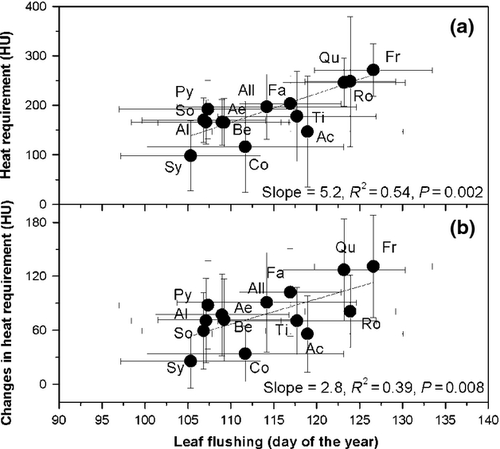
The heat requirement for leaf flushing increased during the study period 1980–2012 at almost all observation sites (97%; significantly at ~30%; Fig. 2, black histogram). With an average increment of 30 HU decade−1, the heat requirement increased by almost 50% (averaged across all species, Table 1). The temporal increase in heat requirement for leaf flushing was observed in all species, but was much larger for late than for early flushing species (Fig. 3b). For example, compared to 1980, more than 120 extra heat units are now required for flushing of late species, such as Q. robur and Fraxinus excelsior, whereas only ~30 extra heat units are required for the early species S. chinensis and Corylus avellana (Fig. 3b and Table 1). On average, across the 13 study species, each day delay in leaf flushing corresponds to an increase in the heat requirement of almost 3 heat units (Fig. 3b).
Changes in climate and chilling requirement over 1980–2012
Averaged across all our observation sites, the mean temperature during the dormancy period increased by 1.4 °C over the period 1980–2012. While temperature increased at almost 90% of the study sites, this increase was significant at only 5% of the sites (at P < 0.05; Fig. 4a), which was likely due to the nonlinear warming pattern over the study period. In parallel with the warming trend, the sum of insolation substantially increased at more than 80% of the sites (Fig. 4b), suggesting more occurrences of clear-sky conditions, with a mean increment of 516 W m−2 over the period 1980–2012. In agreement with the increase of clear-sky conditions, precipitation sum declined during this period at 80% of the sites, with a mean reduction of 75 mm (Fig. 4c). As expected in relation to the warming trend, chilling accumulation was reduced at almost all sites (90% of sites showed a trend, which was significant at p < 0.05 in more than 30% of the sites, Fig. 4d), with the average reduction amounting to chilling days.
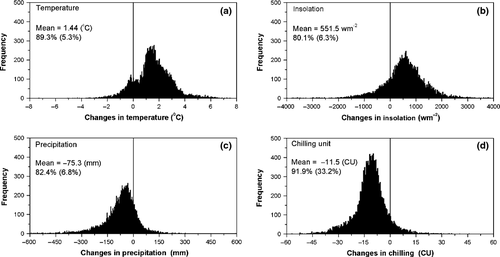
Correlations between heat requirement and other environmental factors
The heat requirement for leaf flushing was negatively correlated with the chilling requirement at almost 90% of the study sites (mean partial correlation coefficient r = −0.30), and this correlation was significant at more than 30% of the sites (Fig. 5, black histogram). This negative correlation was found in all study species, but was much less pronounced in Acer platanoides and S. chinensis (Fig 6, left panels).
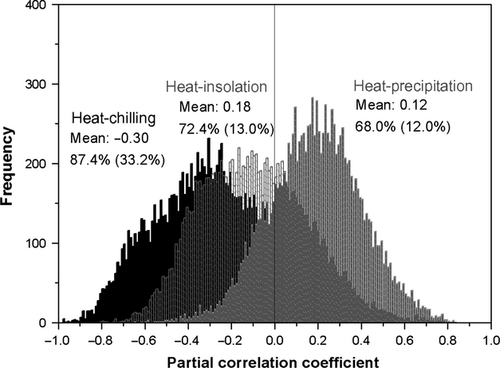
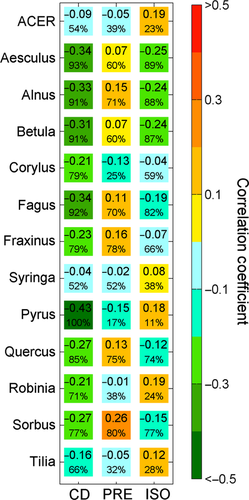
Interestingly, the partial correlation analysis also revealed the predominance of a negative partial correlation between heat requirement and insolation sum during dormancy at more than 70% of the observation sites, with an average partial correlation coefficient of −0.18 (Fig 5, light grey histogram). This means that under similar chilling conditions and precipitation, years with more insolation tend to lead to earlier leaf flushing (in response to the reduced heat requirement). This negative correlation was found in 8 of the 13 species (Fig. 6, right panels), while the opposite pattern was found in Acer platanoides (r = 0.19), Pyrus communis (r = 0.18), Robinia pseudoacacia (r = 0.19), S. chinensis (r = 0.08) and Tilia cordata (r = 0.12). This result suggests that the amount of insolation during dormancy may influence the heat requirement for leaf flushing, but that the impact is species specific.
In contrast to chilling and insolation sum, a predominantly positive partial correlation was found between heat requirement and precipitation sum during dormancy at around 70% of the observation sites (Fig. 5, dark grey histogram, average partial correlation coefficient, r = 0.12). This partial correlation was, however, species specific and the positive correlation was only found in seven species (Fig. 6, middle panels). Two species even showed a rather strong negative correlation between heat requirement and precipitation sum, that is C. avellana (r = −0.13) and Pyrus communis (r = −0.15). This predominantly positive correlation implies that under wetter conditions (= more cloudy), more heat is needed to trigger leaf flush under similar chilling accumulation.
Discussion
Heat requirement for leaf flushing increased over 1980–2012
In the Northern Hemisphere, the last three decades were likely the warmest 30-year period during the previous millennia (IPCC, 2014). Averaged across all our study sites, the mean temperature during dormancy increased by 1.4 °C throughout the 1980–2012 period, which is twice the global warming rate over the same time period (i.e. 0.74 °C, IPCC, 2014). Numerous studies have revealed that climate warming has substantially advanced the spring phenology of temperate plants (Chmielewski & Rotzer, 2001; Fitter & Fitter, 2002; Parmesan & Yohe, 2003; Menzel et al., 2006; Piao et al., 2008; Friedl et al., 2014; Fu et al., 2014b). In line with these results, we found that the timing of leaf flushing across our 13 study species was advanced by 13 days over the 1980–2012 period. Interestingly, we found that the heat requirement for leaf flushing (across the study species) also increased by 50%, which substantially moderated the advancing trend of leaf flushing in response to warming and demonstrates that phenological responses to temperature increase are not necessarily linear (Morin et al., 2010; Fu et al., 2012b).
The increasing heat requirement for leaf flushing was negatively correlated with chilling accumulation and with insolation sum, and positively correlated with precipitation sum. During the study period 1980–2012, we found decreased chilling accumulation and precipitation sum, but increased insolation sum. The combination of these factors finally resulted in an increment of heat requirement for leaf flushing. Furthermore, as expected, we found species-specific differences in the heat requirement shifts with the ongoing warming trend, that is much larger heat requirement shifts in late- than in early flushing species, which is consistent with previous studies (Murray et al., 1989; Vitasse et al., 2009; Fu et al., 2013). The larger increment of heat requirement for late flushing species may mainly relate to the larger chilling requirement deficit (chilling requirement minus chilling accumulation) due to climate warming (reducing the chilling accumulation), as these later flushing species usually require more chilling to fully break bud dormancy, especially Fagus sylvatica (Vitasse et al., 2009; Harrington et al., 2010; Vitasse & Basler, 2013).
Partial correlations between heat requirement and chilling, precipitation and insolation
The heat requirement has been widely identified as the primary driver for leaf flushing in temperate woody species (Cannell & Smith, 1983; Hänninen, 1990; Chuine, 2000; Fu et al., 2013; Friedl et al., 2014). However, the causal mechanisms that determine the interannual variation in the heat requirement for leaf flushing remain poorly understood. Consistent with previous studies, we found that the heat requirement negatively correlates with chilling accumulation (Murray et al., 1989; Zhang et al., 2004; Harrington et al., 2010; Vitasse & Basler, 2013). However, after removing the variation induced by chilling accumulation in the partial correlation analysis, we also observed a predominantly positive partial correlation between heat requirement and precipitation, and a predominantly negative correlation with insolation, both summed during dormancy period. A similar correlation between heat requirement and precipitation was found in a remote sensing-based study focusing on the spatial correlations across the Northern Hemisphere (Fu et al., 2014c). That spatial analysis also suggested a substantial role for winter precipitation in controlling spring phenological responses to global warming, but these spatial patterns need to hold temporally because space-for-time substitutions may be inappropriate (Jochner et al., 2013; Makela, 2013). Nonetheless, using an in situ dataset and temporal correlation analysis, this study supports the idea of a winter precipitation impact on phenology of deciduous woody species. Previous studies have reported that precipitation influences spring phenology in grassland ecosystems (Stewart & Dwyer, 1994; Yuan et al., 2007), but not noticeably in temperate tree species (Dose & Menzel, 2004; Sherry et al., 2007; Morin et al., 2010). The latter was attributed to the deeper root system, which allows them to reach available water at depth (Sarmiento & Monasterio, 1983). In contrast to these earlier studies, we do find that wetter years result in delayed spring phenology (associated with larger GDD requirement), although we could only detect it in the partial correlation analysis which removes the overriding temperature effects.
The influence of precipitation on spring phenology is apparent, while it remains unclear how precipitation sum could directly affect spring phenology of deciduous woody species, but indirect effects can be proposed. We propose two mutually nonexclusive hypotheses to explain the positive correlation between heat requirement and precipitation sum during dormancy.
First, less precipitation during plant dormancy may imply more clear days and nights, and thereby increase the daytime temperature but reduce the night time temperature (De Boeck et al., 2010). The combination of increased day and reduced night temperatures may result in a stable mean daily temperature. However, chilling accumulation may be more associated with the cooler night temperature than with mean daily temperature. Thus, the lower precipitation may actually indicate increased chilling accumulation that remained undetected in this analysis that used daily mean temperature. Increased chilling could explain the observed reduction of heat requirement at lower rainfall. Second, more clear days could increase both air and meristem temperatures, but the increment of meristem temperature could be much higher than air temperature as measured in standard weather stations, that is 2 m air-temperature recorded in shade conditions (Savvides et al., 2014). These two temperatures are substantially different because under clear-sky conditions buds are heating up at the canopy level, and the leaf flushing process may be more related to the meristem temperature within buds (Grace et al., 1989). Therefore, clear-sky conditions may fullfil the meristem temperature-based heat requirement earlier than the air temperature-based heat requirement as calculated in this study.
This would also explain the negative correlation between heat requirement and the insolation sum (Fig. 2b). However, how exactly the insolation sum may affect leaf flushing process remains poorly understood, although it has been widely reported as an important factor, at least in its day length component (Murray et al., 1989; Körner & Basler, 2010; Caffarra & Donnelly, 2011; Basler & Körner, 2012, 2014). Some studies have claimed that insolation sum could directly modulate the heat requirement, independent of chilling (Wareing, 1953). Most studies, however, have suggested that the insolation sum effect is greater when there is a deficit in the amount of accumulated chilling (Falusi & Calamassi, 1996; Caffarra & Donnelly, 2011; Basler & Körner, 2014) and may not play a significant role in case of sufficient chilling (Kramer, 1994b; Fu et al., 2012a; Laube et al., 2014). In addition, species-specific differences in the insolation sum of spring leaf flushing phenology should be considered (Basler & Körner, 2012, 2014). In our study, we used insolation sum as an integrating value of day length and light intensity over the dormancy period and found a predominantly negative, but species-specific, correlation between insolation sum and heat requirement. Thus, all else being equal, more insolation advances leaf flushing in most species. However, the underlying mechanism through which insolation sum affects spring leaf flushing remains poorly understood in temperate woody species and requires additional, well-designed manipulation experiments.
Limitations and implications
In this study, we estimated the heat requirement for leaf flushing using an in situ phenology dataset for Northern Hemispheric temperate woody species and investigated the role of environmental factors in the heat requirement by applying a partial correlation analysis to exclude the covariate effects between these factors. This approach helped us to better understand how different environmental factors influence the heat requirement for leaf flushing of different species. Nonetheless, caution should be taken. First, the parameter values of the sigmoid function for heat requirement were calculated following Hänninen (1990), based on Sarvas' (Sarvas, 1972) experimental results on Finnish birch and poplar saplings. Similarly, accumulated chilling was calculated using arbitrary thresholds, albeit this too was based on empirical observations. These parameter values likely differ among species, climatic conditions and even life stages (Luedeling, 2012; Vitasse, 2013). Evaluating the species-specific parameter values is beyond the scope of this study, but would likely reduce the uncertainty of both heat and chilling requirement estimates. A second limitation of this study is that we calculated the heat accumulation from the average daily temperatures. However, within-day temperature variations have been found to influence heat accumulation (Chung et al., 2009). Furthermore, a recent study reported that the period preceding leaf flushing exerts a disproportional influence on leaf flushing (Friedl et al., 2014). Therefore, a detailed study of which periods and times of day contribute most to heat accumulation could fine tune the interpretation of the phenology observations and reduce the uncertainty of our results.
Nonetheless, the results of this study do have important implications for improving the understanding of spring leaf flushing. The present study suggests that besides the well-known effect of chilling, the heat requirement for leaf flushing is also influenced by precipitation and insolation sum during dormancy, either directly or indirectly. We speculate that the observed precipitation and insolation effects might be due to the inappropriate use of standard air temperature record in the heat requirement estimation, instead, meristem temperature is likely more directly related to the leaf flushing process. To date, the mechanisms through which chilling, precipitation and insolation affect the leaf flushing process remain unclear. Experimental efforts are needed to improve our understanding of the interactions between heat requirement and other environmental factors, as well as to improve our understanding of the different effects of air and meristem temperature on leaf flushing, and ultimately result in more accurate simulation of spring phenology and better understanding of the ecosystems response to future climate warming.
Acknowledgements
This study was supported by the National Natural Science Foundation of China (41125004), National Basic Research Program of China (2013CB956303), and National Youth Top-notch Talent Support Program in China. Ivan A. Janssens acknowledges support from the European Research Council through Synergy grant 610028 ‘P-IMBALANCE’ and from the University of Antwerp Centre of Excellence ‘Eco’.



